 The hydrogen economy is regarded as the most promising alternative energy system, relying on hydrogen produced through sustainable water splitting, which in turn depends onefficient electrocatalysts.The PtAuCu A1 phase alloy has been predicted to be a promising electrocatalyst for hydrogen evolution.However, due to the thermodynamic instability of this preferred phase of Pt-Au-Cu,this study stabilizes the PtAuCu alloy by constructing high-entropy phase nanowires.Density functional theory (DFT) calculations indicate that, compared to ordered phases with discrete hydrogen binding energies and separated phases, the high-entropy phase provides a diverse combination of sites that can continuously modulate hydrogen binding energy, resulting in a range of highly active hydrogen evolution sites. Consistent with theoretical predictions, electrochemical tests show that A1 phase PtAuCu nanowires significantly outperform the phase-separated nanoparticle form in hydrogen evolution electrocatalysis, making them one of the best-performing electrocatalysts for hydrogen evolution.
The hydrogen economy is regarded as the most promising alternative energy system, relying on hydrogen produced through sustainable water splitting, which in turn depends onefficient electrocatalysts.The PtAuCu A1 phase alloy has been predicted to be a promising electrocatalyst for hydrogen evolution.However, due to the thermodynamic instability of this preferred phase of Pt-Au-Cu,this study stabilizes the PtAuCu alloy by constructing high-entropy phase nanowires.Density functional theory (DFT) calculations indicate that, compared to ordered phases with discrete hydrogen binding energies and separated phases, the high-entropy phase provides a diverse combination of sites that can continuously modulate hydrogen binding energy, resulting in a range of highly active hydrogen evolution sites. Consistent with theoretical predictions, electrochemical tests show that A1 phase PtAuCu nanowires significantly outperform the phase-separated nanoparticle form in hydrogen evolution electrocatalysis, making them one of the best-performing electrocatalysts for hydrogen evolution.
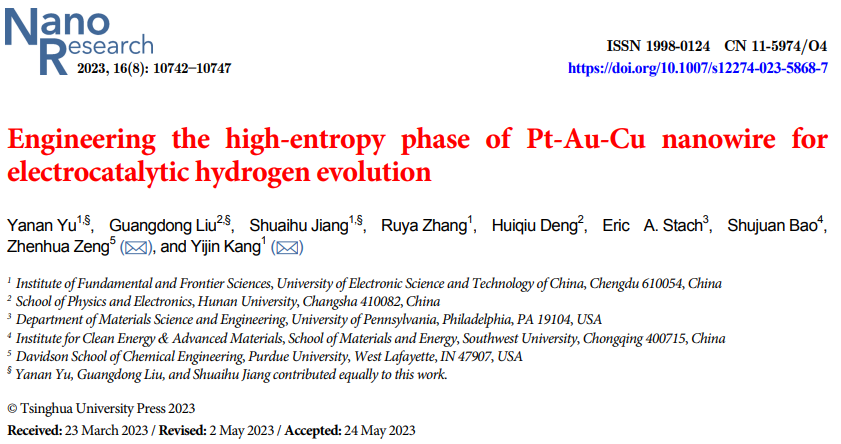 01 Research Background and Objectives
Background:The hydrogen economy is seen as the most promising alternative energy system for the future, with its core relying on hydrogen produced through sustainable water splitting, which depends on efficient electrocatalysts.The PtAuCu A1 phase alloy is predicted to be a promising electrocatalyst for the hydrogen evolution reaction (HER) due to its appropriate hydrogen binding energy.
Objective:Although the PtAuCu 1:1:1 alloy phase is predicted to be the best choice for HER electrocatalysts, the synthesis of non-separated phases has been challenging due to its thermodynamic instability.This study aims to synthesize high-entropy PtAuCu nanowires through structure-guided and synchronous co-reduction of metal precursors and evaluate their HER performance.
Material Synthesis:High-entropy PtAuCu nanowires were synthesized using the strong reducing agent NaBH4 in the presence of Triton X-100 as a shape directing agent through structure-guided and synchronous co-reduction of metal precursors.
Characterization Techniques:The structure, composition, and phase purity of the nanowires were characterized using techniques such as transmission electron microscopy (TEM), X-ray diffraction (XRD), and energy-dispersive X-ray spectroscopy (EDS).
Performance Testing:Hydrogen binding energy was simulated through density functional theory (DFT), and HER performance was evaluated through electrochemical experiments.
Structural Features:The synthesized PtAuCu nanowires exhibit stable A1 phase without phase separation even after annealing, indicating the excellent stability of their high-entropy A1 phase.
HER Performance:DFT calculations indicate thatthe formation of the high-entropy phase promotes the generation of numerous highly active sites.
Electrochemical tests show that PtAuCu nanowires exhibit higher HER activity compared to PtAuCu nanoparticles with slight phase separation and commercial Pt/C electrocatalysts.
Environmental Adaptability:The PtAuCu catalyst also demonstrates good HER performance in alkaline (1 M KOH) and neutral electrolyte (1 M PBS).
01 Research Background and Objectives
Background:The hydrogen economy is seen as the most promising alternative energy system for the future, with its core relying on hydrogen produced through sustainable water splitting, which depends on efficient electrocatalysts.The PtAuCu A1 phase alloy is predicted to be a promising electrocatalyst for the hydrogen evolution reaction (HER) due to its appropriate hydrogen binding energy.
Objective:Although the PtAuCu 1:1:1 alloy phase is predicted to be the best choice for HER electrocatalysts, the synthesis of non-separated phases has been challenging due to its thermodynamic instability.This study aims to synthesize high-entropy PtAuCu nanowires through structure-guided and synchronous co-reduction of metal precursors and evaluate their HER performance.
Material Synthesis:High-entropy PtAuCu nanowires were synthesized using the strong reducing agent NaBH4 in the presence of Triton X-100 as a shape directing agent through structure-guided and synchronous co-reduction of metal precursors.
Characterization Techniques:The structure, composition, and phase purity of the nanowires were characterized using techniques such as transmission electron microscopy (TEM), X-ray diffraction (XRD), and energy-dispersive X-ray spectroscopy (EDS).
Performance Testing:Hydrogen binding energy was simulated through density functional theory (DFT), and HER performance was evaluated through electrochemical experiments.
Structural Features:The synthesized PtAuCu nanowires exhibit stable A1 phase without phase separation even after annealing, indicating the excellent stability of their high-entropy A1 phase.
HER Performance:DFT calculations indicate thatthe formation of the high-entropy phase promotes the generation of numerous highly active sites.
Electrochemical tests show that PtAuCu nanowires exhibit higher HER activity compared to PtAuCu nanoparticles with slight phase separation and commercial Pt/C electrocatalysts.
Environmental Adaptability:The PtAuCu catalyst also demonstrates good HER performance in alkaline (1 M KOH) and neutral electrolyte (1 M PBS).

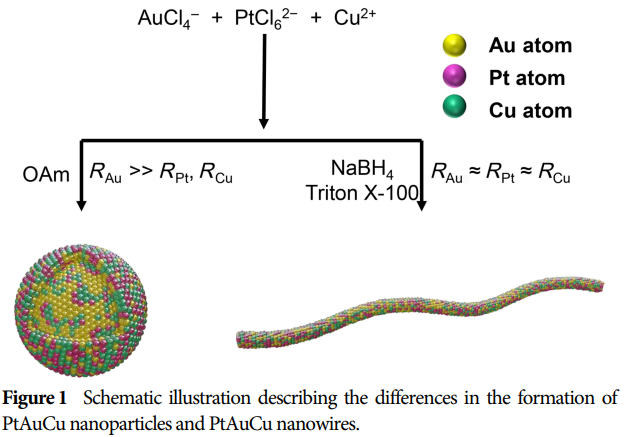
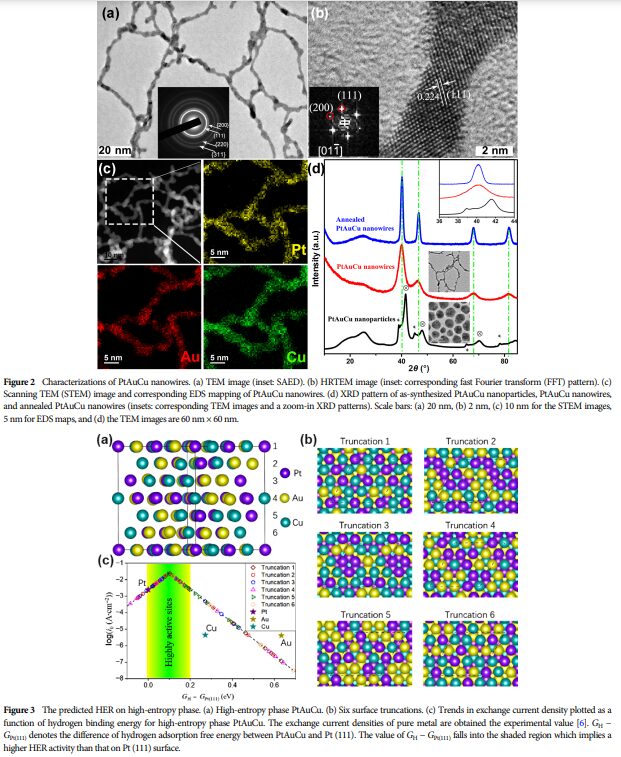
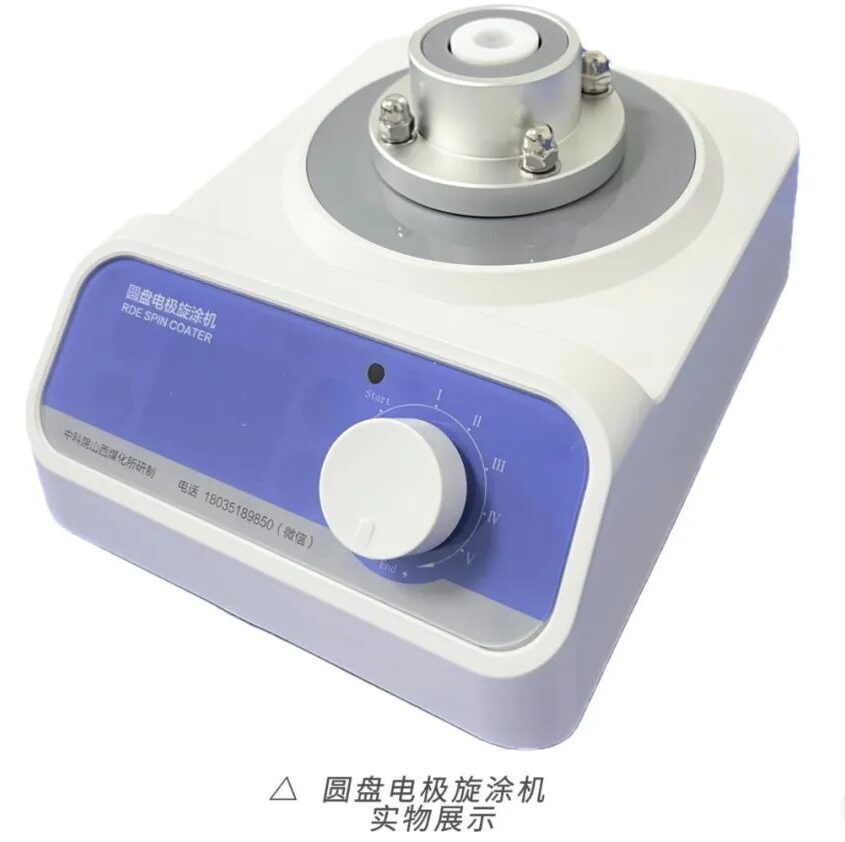
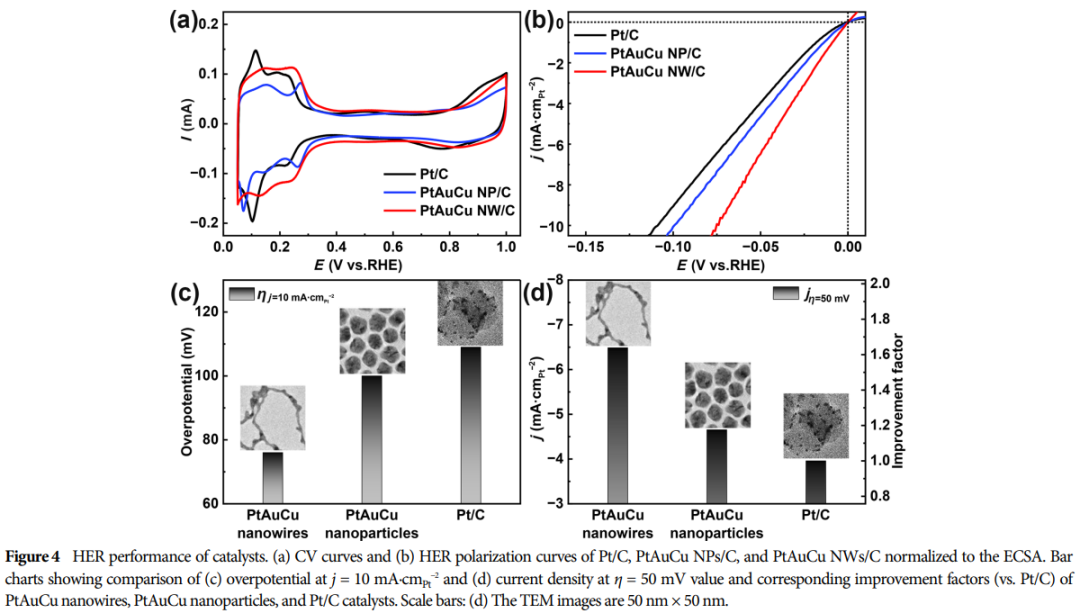
-
This study emphasizes the importance of phase purity in catalyst design and provides a pathway for preparing non-thermodynamically stable high-activity alloy materials.
-
The discovery of PtAuCu nanowires offers an efficient electrocatalyst for HER, promoting the development of the hydrogen economy.
Although this study successfully synthesized high-entropy PtAuCu nanowires and demonstrated their excellent HER performance, further evaluation of their long-term stability and durability in practical applications is needed.
07 Future Research Directions
-
Explore the potential of more non-thermodynamically stable alloy materials as electrocatalysts.
-
Further investigate the relationship between the structure and performance of catalysts to optimize HER performance.
-
Assess the application potential of PtAuCu nanowires in practical hydrogen energy systems.
In summary, this article achieves a significant enhancement in the performance of HER electrocatalysts through the synthesis of high-entropy PtAuCu nanowires, providing strong support for the development of the hydrogen economy.
This article is provided by the Hydrogen Energy Research Assistant.
Original link:
https://www.sciopen.com/article/download_ris?tag=2&id=1661628864068677633
▲ Disc Electrode Spin Coater






